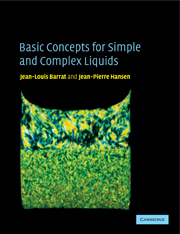Book contents
- Frontmatter
- Contents
- Preface
- 1 An introduction to liquid matter
- I Thermodynamics, structure and fluctuations
- II Phase transitions
- III Interfaces and inhomogeneous fluids
- IV Dynamics
- 9 Phenomenological description of transport processes
- 10 Brownian motion, diffusion and the Langevin equation
- 11 Response and correlation functions
- 12 Slow relaxations
- Index
11 - Response and correlation functions
Published online by Cambridge University Press: 06 January 2010
- Frontmatter
- Contents
- Preface
- 1 An introduction to liquid matter
- I Thermodynamics, structure and fluctuations
- II Phase transitions
- III Interfaces and inhomogeneous fluids
- IV Dynamics
- 9 Phenomenological description of transport processes
- 10 Brownian motion, diffusion and the Langevin equation
- 11 Response and correlation functions
- 12 Slow relaxations
- Index
Summary
Probing dynamical properties at equilibrium
By definition, the macroscopic properties of a system at equilibrium do not change with time. This does not mean, however, that the system is dynamically inert. On the contrary, the equilibrium state is associated with permanent motion at the molecular level. Although this motion is sometimes described as random ‘thermal noise’, it is in fact quite well organized, and reflects the microscopic processes that govern the dynamics of the system. As these same processes will also determine the system response to an external perturbation, understanding their organization and time evolution is of primary importance for the determination of the material response, and of its relationship to the microscopic structure.
As a simple illustration of how seemingly random dynamical processes are organized in a coherent fashion, one may consider the case of vibrations in a crystalline solid. Each atom oscillates around its equilibrium position, in a way which is apparently very random. The well known harmonic analysis, however, shows that this motion is really caused by the superposition of well defined sound waves, the phonons, with different phases and directions of propagation. This organization of the atomic motions into excitations of well defined spatial and temporal structure determines many thermodynamic and transport properties of the crystal.
The harmonic crystal is of course particularly simple, since it is possible in that case to deduce analytically from the interaction potential the structure of the coherent excitations. In more complex, disordered systems, an analytical treatment is usually out of reach. Nevertheless, the information on the way atomic motions are organized is encoded in the correlation functions of atomic positions.
Information
- Type
- Chapter
- Information
- Basic Concepts for Simple and Complex Liquids , pp. 257 - 272Publisher: Cambridge University PressPrint publication year: 2003
